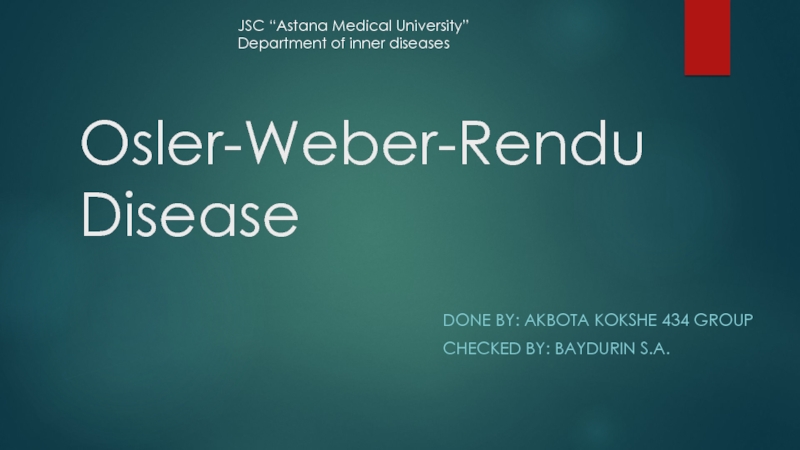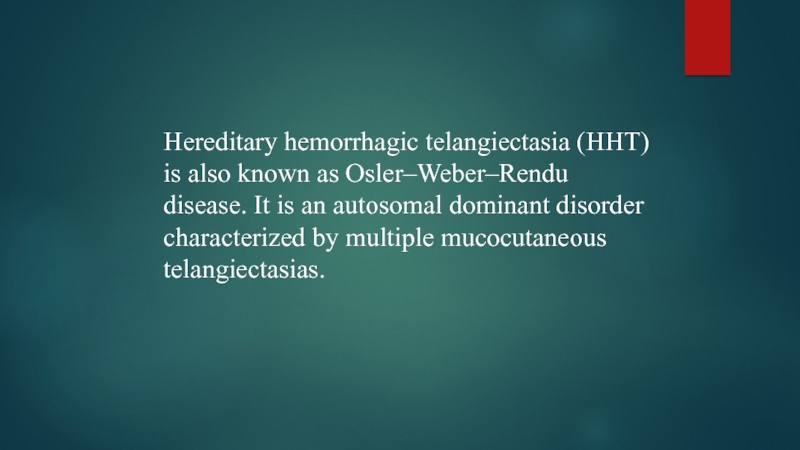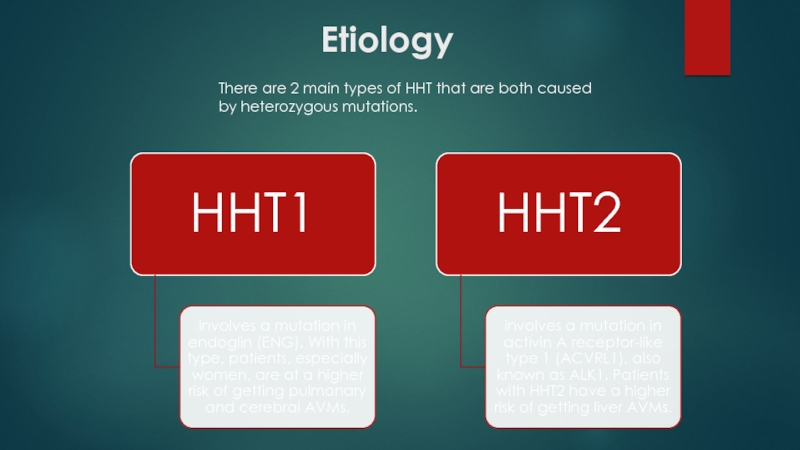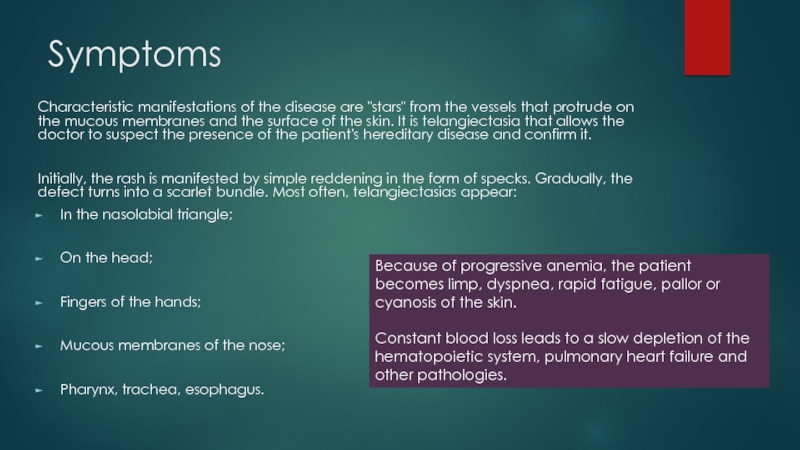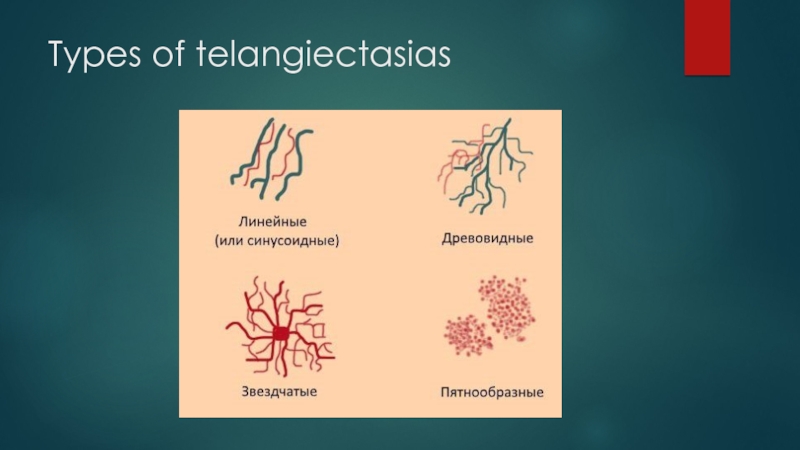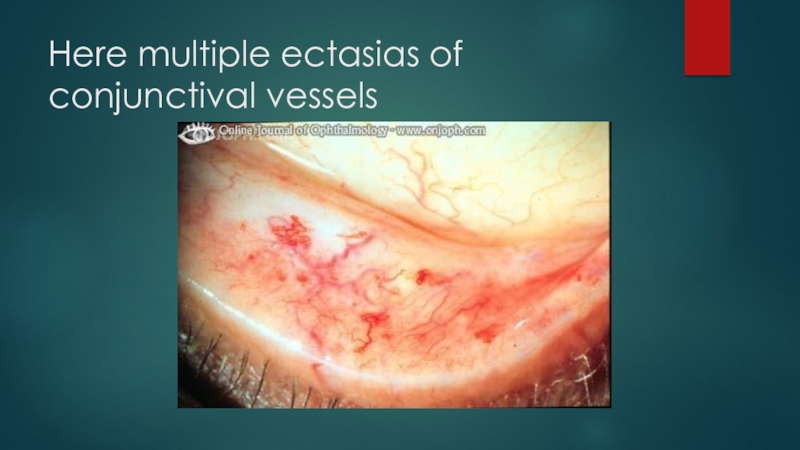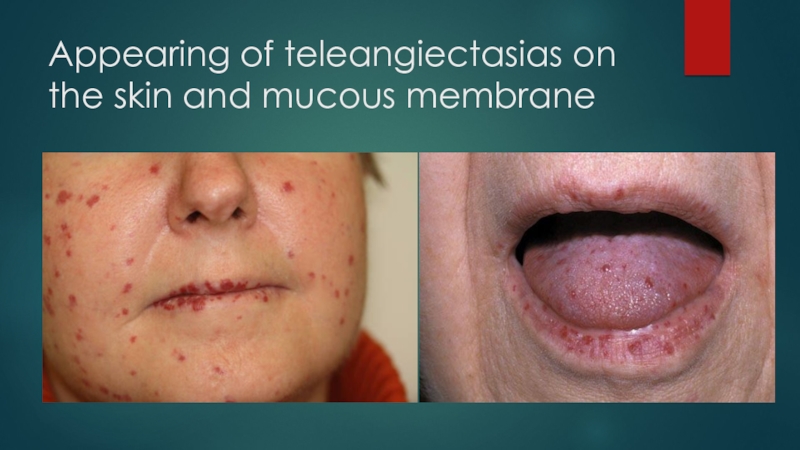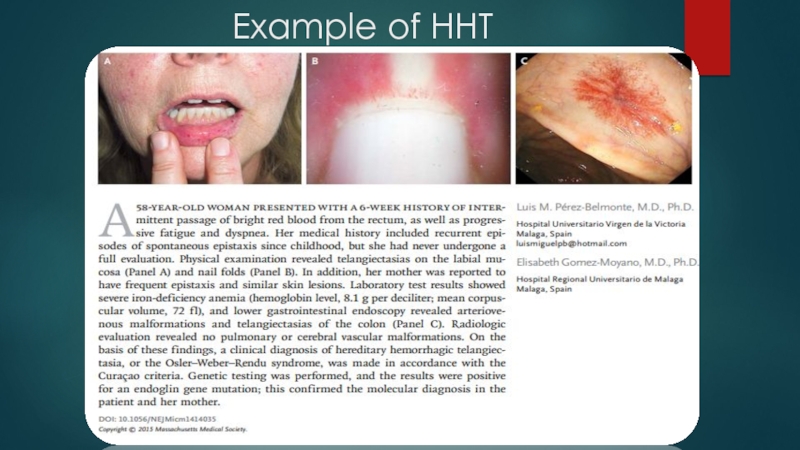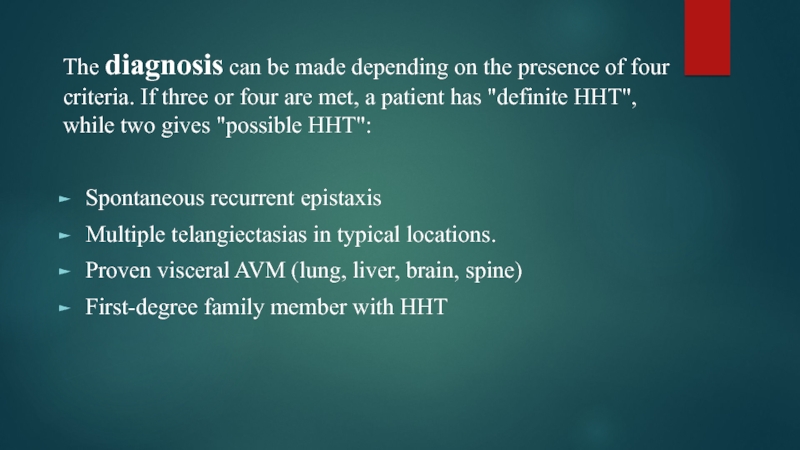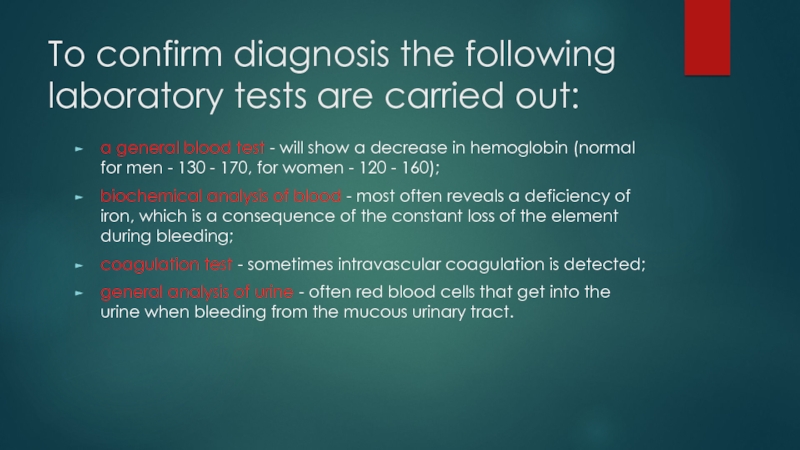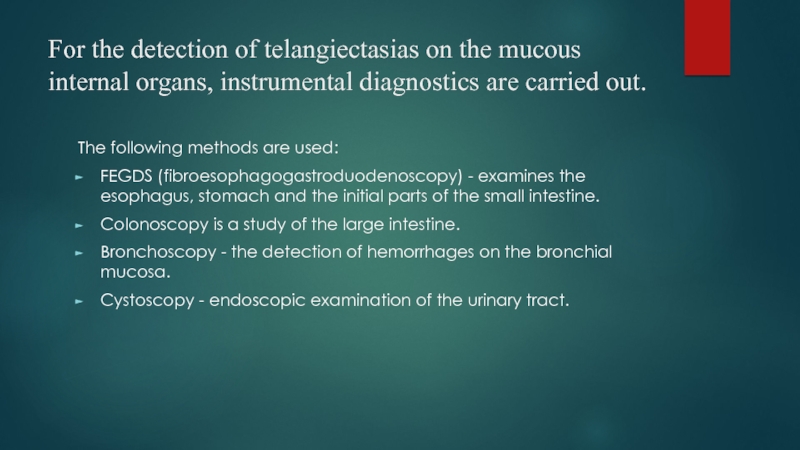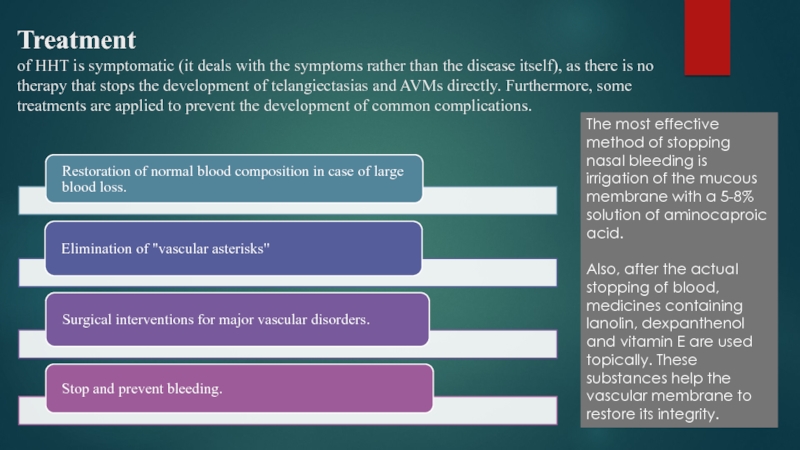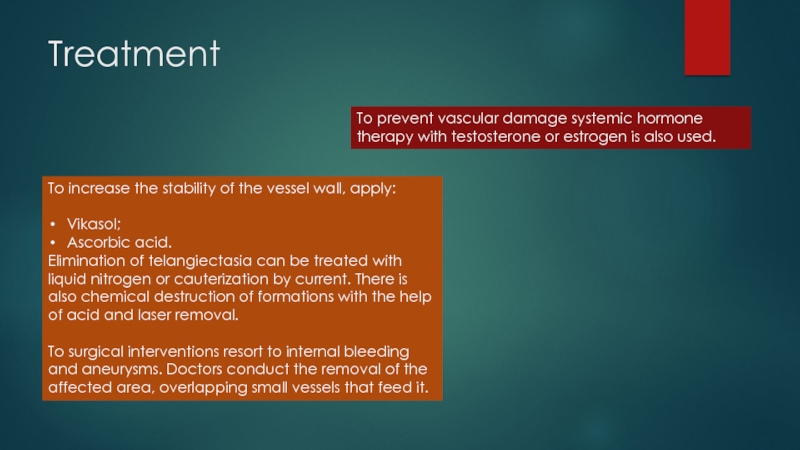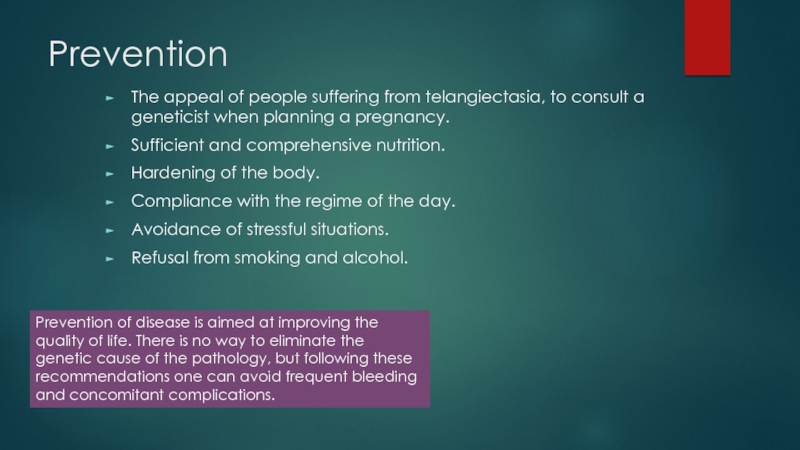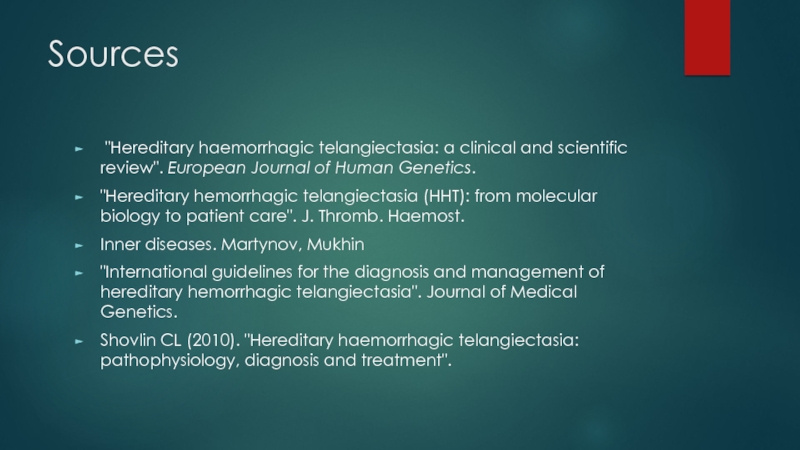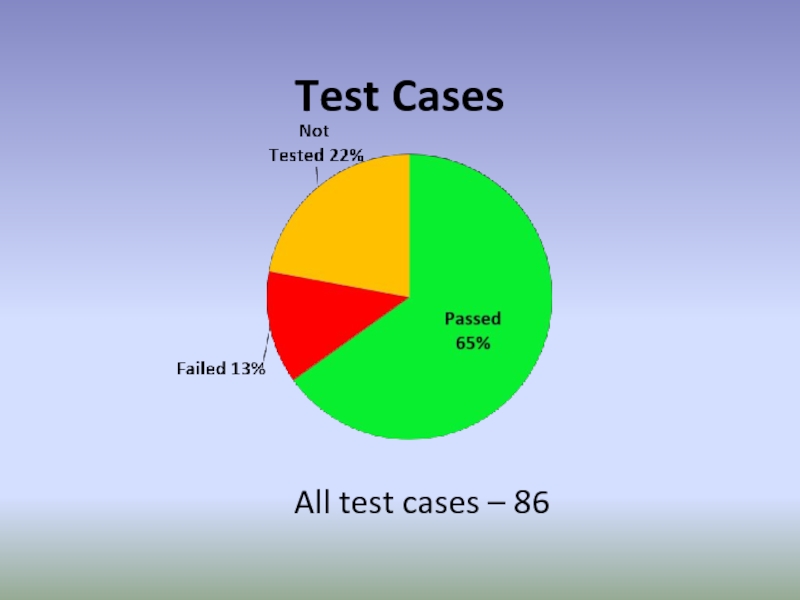- Главная
- Разное
- Дизайн
- Бизнес и предпринимательство
- Аналитика
- Образование
- Развлечения
- Красота и здоровье
- Финансы
- Государство
- Путешествия
- Спорт
- Недвижимость
- Армия
- Графика
- Культурология
- Еда и кулинария
- Лингвистика
- Английский язык
- Астрономия
- Алгебра
- Биология
- География
- Детские презентации
- Информатика
- История
- Литература
- Маркетинг
- Математика
- Медицина
- Менеджмент
- Музыка
- МХК
- Немецкий язык
- ОБЖ
- Обществознание
- Окружающий мир
- Педагогика
- Русский язык
- Технология
- Физика
- Философия
- Химия
- Шаблоны, картинки для презентаций
- Экология
- Экономика
- Юриспруденция
Osler-Weber-Rendu Disease презентация
Содержание
- 1. Osler-Weber-Rendu Disease
- 2. Hereditary hemorrhagic telangiectasia (HHT) is also known
- 3. Etiology There are 2 main types
- 4. Symptoms Characteristic manifestations of the disease are
- 5. Types of telangiectasias
- 6. Due to the occurrence of these localizations, there may be:
- 7. Here multiple ectasias of conjunctival vessels
- 8. Appearing of teleangiectasias on the skin and mucous membrane
- 9. Example of HHT
- 10. The diagnosis can be made depending on
- 11. To confirm diagnosis the following laboratory tests
- 12. For the detection of telangiectasias on the
- 13. Treatment of HHT is symptomatic (it
- 14. Treatment To prevent vascular damage systemic hormone
- 15. Prevention The appeal of people suffering from
- 16. Sources "Hereditary haemorrhagic telangiectasia: a clinical
Слайд 1Osler-Weber-Rendu Disease
DONE BY: AKBOTA KOKSHE 434 GROUP
CHECKED BY: BAYDURIN S.A.
JSC “Astana
Department of inner diseases
Слайд 2Hereditary hemorrhagic telangiectasia (HHT) is also known as Osler–Weber–Rendu disease. It
Слайд 4Symptoms
Characteristic manifestations of the disease are "stars" from the vessels that
Initially, the rash is manifested by simple reddening in the form of specks. Gradually, the defect turns into a scarlet bundle. Most often, telangiectasias appear:
In the nasolabial triangle;
On the head;
Fingers of the hands;
Mucous membranes of the nose;
Pharynx, trachea, esophagus.
Because of progressive anemia, the patient becomes limp, dyspnea, rapid fatigue, pallor or cyanosis of the skin.
Constant blood loss leads to a slow depletion of the hematopoietic system, pulmonary heart failure and other pathologies.
Слайд 10The diagnosis can be made depending on the presence of four
Spontaneous recurrent epistaxis
Multiple telangiectasias in typical locations.
Proven visceral AVM (lung, liver, brain, spine)
First-degree family member with HHT
Слайд 11To confirm diagnosis the following laboratory tests are carried out:
a general
biochemical analysis of blood - most often reveals a deficiency of iron, which is a consequence of the constant loss of the element during bleeding;
coagulation test - sometimes intravascular coagulation is detected;
general analysis of urine - often red blood cells that get into the urine when bleeding from the mucous urinary tract.
Слайд 12For the detection of telangiectasias on the mucous internal organs, instrumental
The following methods are used:
FEGDS (fibroesophagogastroduodenoscopy) - examines the esophagus, stomach and the initial parts of the small intestine.
Colonoscopy is a study of the large intestine.
Bronchoscopy - the detection of hemorrhages on the bronchial mucosa.
Cystoscopy - endoscopic examination of the urinary tract.
Слайд 13Treatment of HHT is symptomatic (it deals with the symptoms rather
The most effective method of stopping nasal bleeding is irrigation of the mucous membrane with a 5-8% solution of aminocaproic acid.
Also, after the actual stopping of blood, medicines containing lanolin, dexpanthenol and vitamin E are used topically. These substances help the vascular membrane to restore its integrity.
Слайд 14Treatment
To prevent vascular damage systemic hormone therapy with testosterone or estrogen
To increase the stability of the vessel wall, apply:
Vikasol;
Ascorbic acid.
Elimination of telangiectasia can be treated with liquid nitrogen or cauterization by current. There is also chemical destruction of formations with the help of acid and laser removal.
To surgical interventions resort to internal bleeding and aneurysms. Doctors conduct the removal of the affected area, overlapping small vessels that feed it.
Слайд 15Prevention
The appeal of people suffering from telangiectasia, to consult a geneticist
Sufficient and comprehensive nutrition.
Hardening of the body.
Compliance with the regime of the day.
Avoidance of stressful situations.
Refusal from smoking and alcohol.
Prevention of disease is aimed at improving the quality of life. There is no way to eliminate the genetic cause of the pathology, but following these recommendations one can avoid frequent bleeding and concomitant complications.
Слайд 16Sources
"Hereditary haemorrhagic telangiectasia: a clinical and scientific review". European Journal of
"Hereditary hemorrhagic telangiectasia (HHT): from molecular biology to patient care". J. Thromb. Haemost.
Inner diseases. Martynov, Mukhin
"International guidelines for the diagnosis and management of hereditary hemorrhagic telangiectasia". Journal of Medical Genetics.
Shovlin CL (2010). "Hereditary haemorrhagic telangiectasia: pathophysiology, diagnosis and treatment".
